Related Research Articles

An autogyro, also known as a gyroplane or gyrocopter, is a type of rotorcraft that uses an unpowered rotor in free autorotation to develop lift. Forward thrust is provided independently, by an engine-driven propeller. While similar to a helicopter rotor in appearance, the autogyro's rotor must have air flowing across the rotor disc to generate rotation, and the air flows upwards through the rotor disc rather than down.

Juan de la Cierva y Codorníu, 1st Count of la Cierva was a Spanish civil engineer, pilot and aeronautical engineer. His most famous accomplishment was the invention in 1920 of the first helicopter called Autogiro, a single-rotor type of aircraft that came to be called autogyro in the English language. In 1923, after four years of experimentation, De la Cierva developed the articulated rotor, which resulted in the world's first successful flight of a stable rotary-wing aircraft, with his C.4 prototype.

The Cierva C.30 was an autogyro designed by Juan de la Cierva and built under licence from the Cierva Autogiro Company by A V Roe & Co Ltd (Avro), Lioré-et-Olivier and Focke-Wulf.
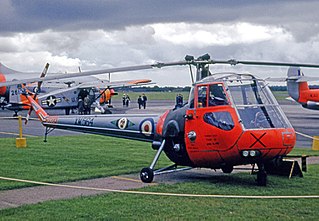
The Saunders-Roe Skeeter was a two-seat training and scout helicopter that was developed and produced by British manufacturer Saunders-Roe ("Saro") of Cowes and Southampton, in the United Kingdom.

A gyrodyne is a type of VTOL aircraft with a helicopter rotor-like system that is driven by its engine for takeoff and landing and also includes one or more conventional propellers to provide forward thrust during cruising flight. Lift during forward flight is provided by a combination of the rotor, like an autogyro, and conventional wings. The gyrodyne is one of a number of similar concepts which attempt to provide helicopter-like low-speed performance and conventional fixed-wing high-speeds, including tiltrotors and tiltwings.
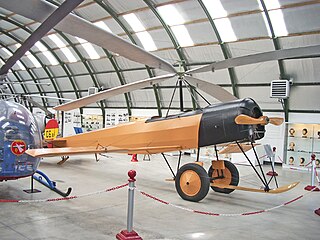
The Cierva C.6 was the sixth autogyro designed by engineer Juan de la Cierva, and the first one to travel a "major" distance. Cierva, the engineer responsible for the invention of the autogyro, had spent all his funds on the research and creation of his first five prototypes. Therefore, in 1923, he turned to the Cuatro Vientos Aerodynamics Laboratory chief, Commander Emilio Herrera, who succeeded in persuading General Francisco Echagüe, the director of the Military Aviation Aeronautics Department, to take over the second stage in the research and development of Cierva's autogyros.

The Pitcairn OP-1 was the first rotary-wing aircraft to be seriously evaluated by any of the world's major air forces. The machine was not a helicopter, nor an airplane, but an autogyro. Pitcairn's model was never put into production for any military.
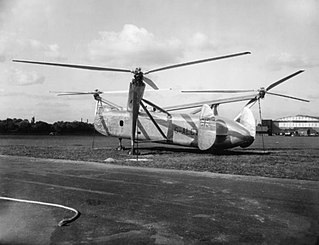
The Cierva W.11 Air Horse was a helicopter developed by the Cierva Autogiro Company in the United Kingdom during the mid-1940s. The largest helicopter in the world at the time of its debut, the Air Horse was unusual for using three rotors mounted on outriggers, and driven by a single engine mounted inside the fuselage.

The Fairey FB-1 Gyrodyne is an experimental British rotorcraft that used single lifting rotor and a tractor propeller mounted on the tip of the starboard stub wing to provide both propulsion and anti-torque reaction.
The Cierva Autogiro Company was a British firm established in 1926 to develop the autogyro. The company was set up to further the designs of Juan de la Cierva, a Spanish engineer and pilot, with the financial backing of James George Weir, a Scottish industrialist and aviator.
The Cierva C.1 was an experimental autogyro built by Juan de la Cierva in Spain in 1920, the forerunner of his successful series of autogyros. The C.1 was created by taking the fuselage from a Deperdussin fixed-wing aircraft and mounting two rotors shaft above it. This shaft carried two coaxial contra-rotating rotors, and atop it a fin for increased lateral stability. When tested, the C.1 refused to take off, which Cierva attributed to interference between the two sets of rotors leading to each set autorotating at a different speed. He considered the possibility of mechanically linking the rotors, but dismissed the idea on the grounds of weight and complexity, and his subsequent efforts would all feature single main rotors. Despite its failure to fly, the C.1 demonstrated the principle of autorotation in a full-sized aircraft for the first time, as it was taxied around the ground.
The Cierva C.2 was an experimental autogyro built by Juan de la Cierva in Spain in 1921-22. Following the failure of the C.1 the previous year, la Cierva started again from scratch, this time taking the fuselage from a Hanriot biplane and adding a five-bladed single rotor to it. Work was interrupted when Cierva ran out of funds, and the machine was not actually completed until 1922, after his next design, the C.3 had already been built and tested. Attempts to fly the aircraft resulted in repeated crashes, and the machine was rebuilt nine times before being finally abandoned.
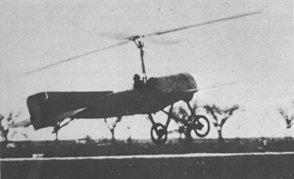
The Cierva C.4 was an experimental autogiro built by Juan de la Cierva in Spain in 1922 which early the following year became the first autogyro to fly successfully. Failures of De la Cierva's attempts to compensate for dissymmetry of lift with the C.1, C.2, and C.3 autogiros, led him to consider alternate means of enabling an autogyro to fly without rolling over. He noted that the problems experienced with his full-size aircraft were not present in the models that he had successfully flown, and considered the difference between the full-size and small-scale rotors. The rotors used on his model were made of bamboo and were thus far more flexible than the ones on his full-size aircraft. While attending an opera he realized that the flexibility eliminated the moments acting on the hub and associated instability. Trained as a civil engineer, Cierva was aware that a cantilever structure hinged to its attachment point generated no moment, and he designed a rotor the blades of which were mounted to the hub through hinges to permit their vertical oscillation.

The Cierva C.8 was an experimental autogyro built by Juan de la Cierva in England in 1926 in association with Avro. Like Cierva's earlier autogyros, the C.8s were based on existing fixed-wing aircraft fuselages – in this case, the Avro 552.
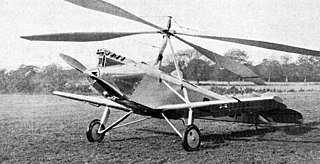
The Cierva C.17 was a British experimental autogyro built by Cierva Autogiro Company in England in 1928, in association with Avro. It was an attempt to build upon the successful Cierva C.8 design using the smaller, more streamlined fuselage of an Avro Avian IIIA as a starting point. The type was found to be underpowered, and when the first attempt at fitting a more powerful engine still did not result in acceptable performance, the design was abandoned.

The Cierva C.19 was a 1930s British two-seat autogyro, designed by Spanish engineer Juan de la Cierva. It was built by Avro as the Avro Type 620. It proved to be the most successful and widely produced of the early de la Cierva designs.

The Kellett KD-1 was a 1930s American autogyro built by the Kellett Autogiro Company. It had the distinction of being the first practical rotary-wing aircraft used by the United States Army and inaugurated the first scheduled air-mail service using a rotary-wing aircraft.
The Cierva C.40 was a British autogyro designed by G.B.L. Ellis, Otto Reder, and J.A.J Bennett and assembled by the British Aircraft Manufacturing Company at London Air Park, Hanworth.
The Westland CL.20 was a two-seat autogyro designed and built by Westland Aircraft between 1934 and 1938. One flying prototype and six airframes were built, which had control problems and insufficient lift. Before these problems could be solved the programme was abandoned and the prototype was scrapped in 1938.

The Cierva C.7 was an experimental autogiro designed by Juan de la Cierva and built in the late 1920s.
References
- Taylor, Michael J. H. (1989). Jane's Encyclopedia of Aviation. London: Studio Editions. p. 254.
- World Aircraft Information Files. London: Bright Star Publishing. pp. File 891 Sheet 28.
- Leishman, J. Gordon (2006). Principles of Helicopter Aerodynamics. Cambridge: Cambridge University Press. p. 699.